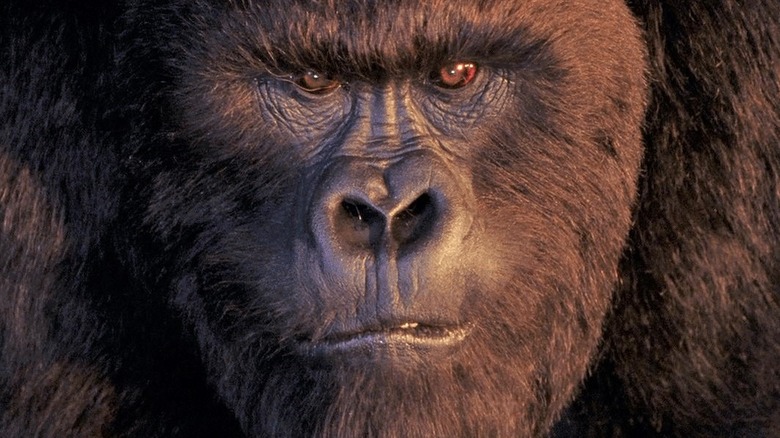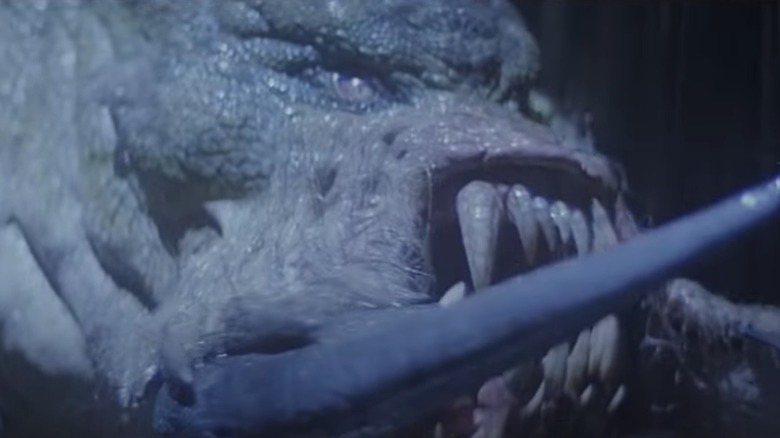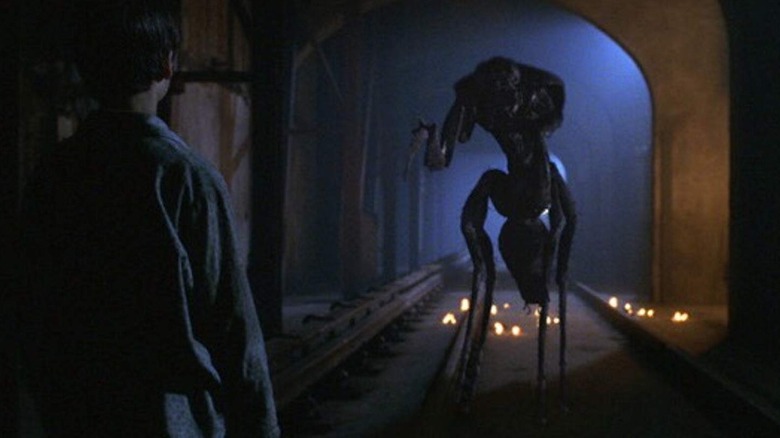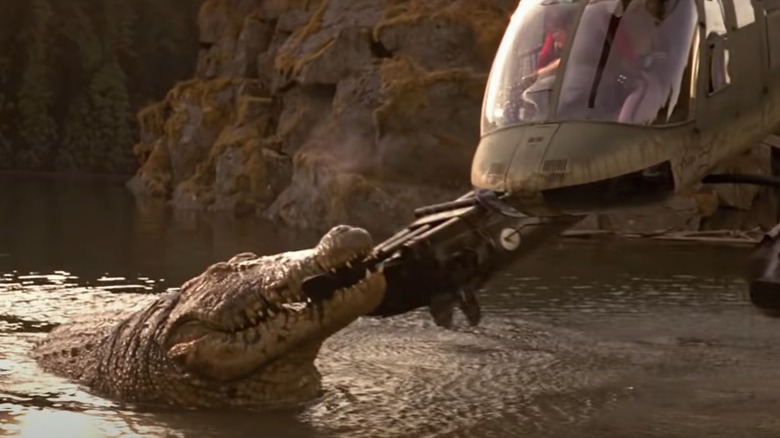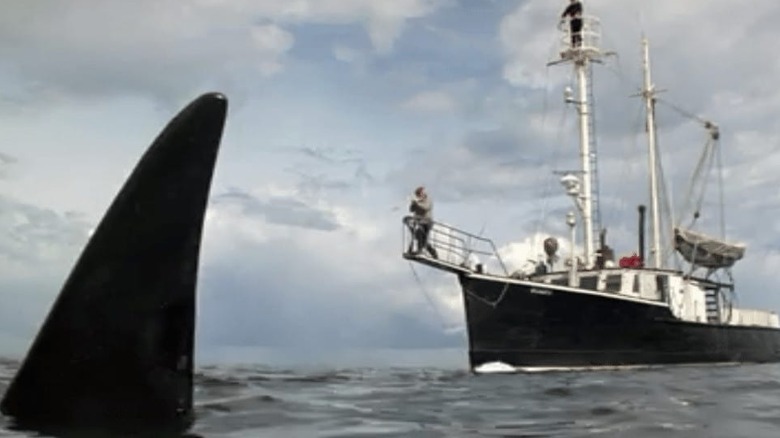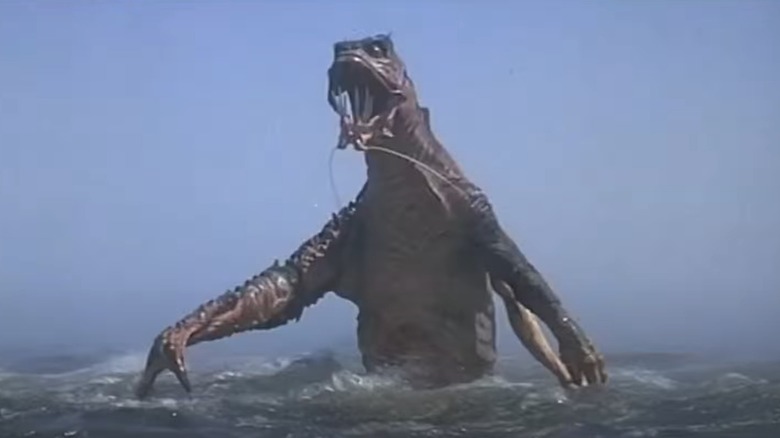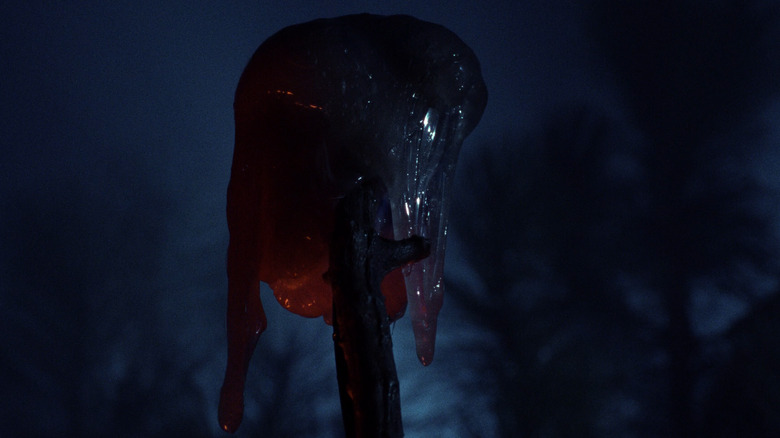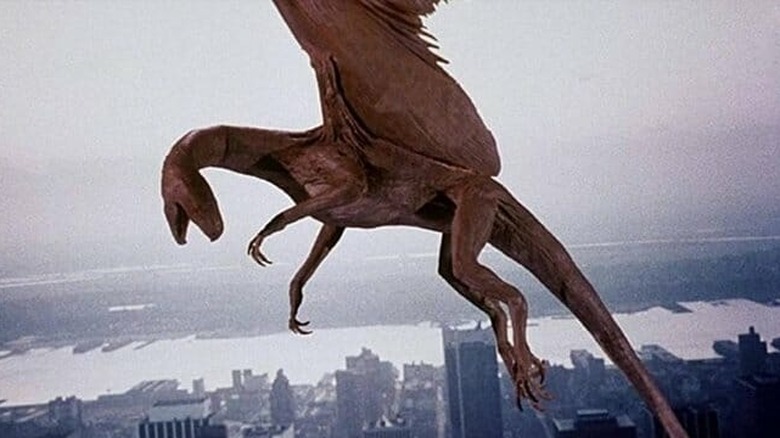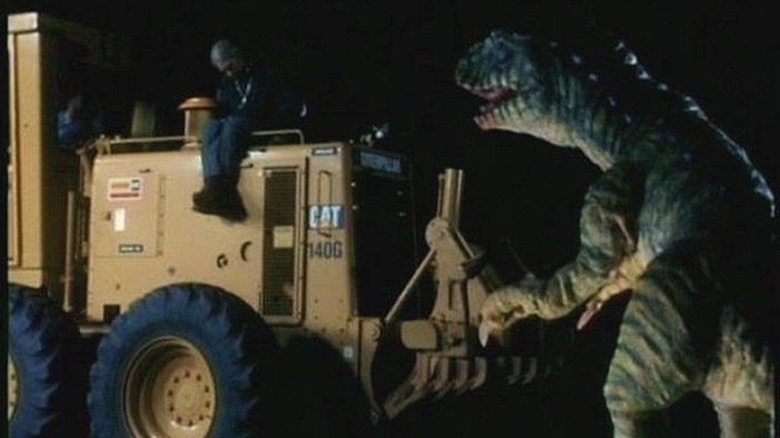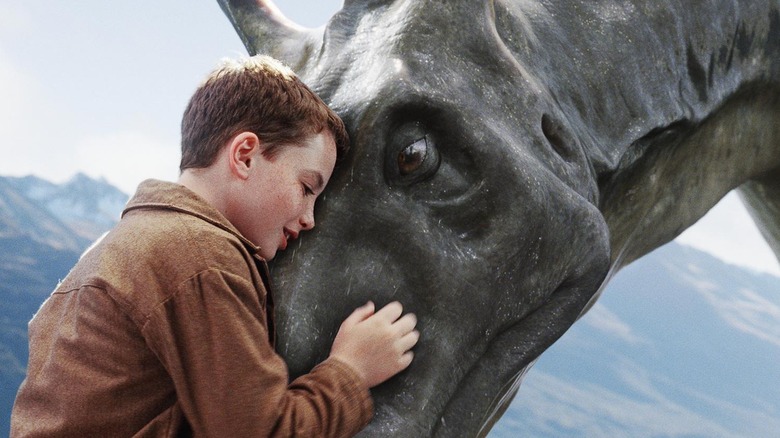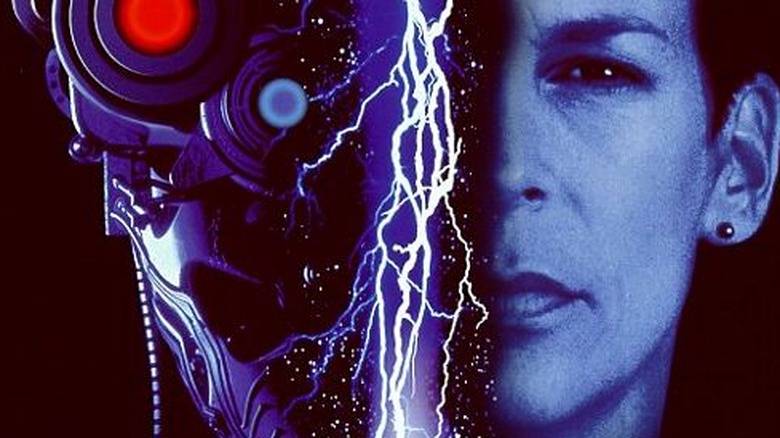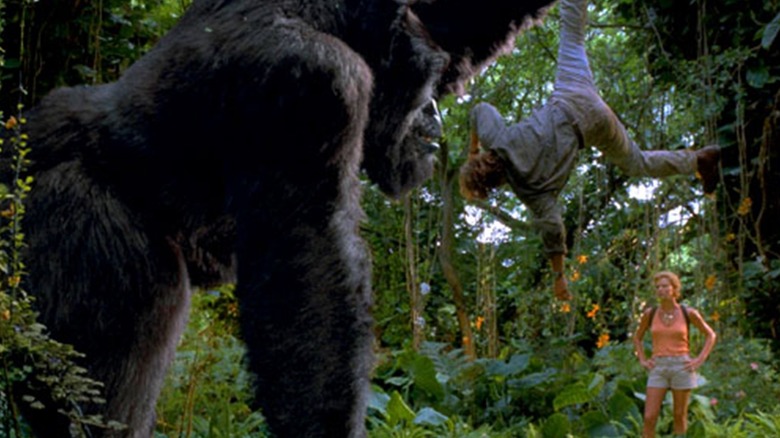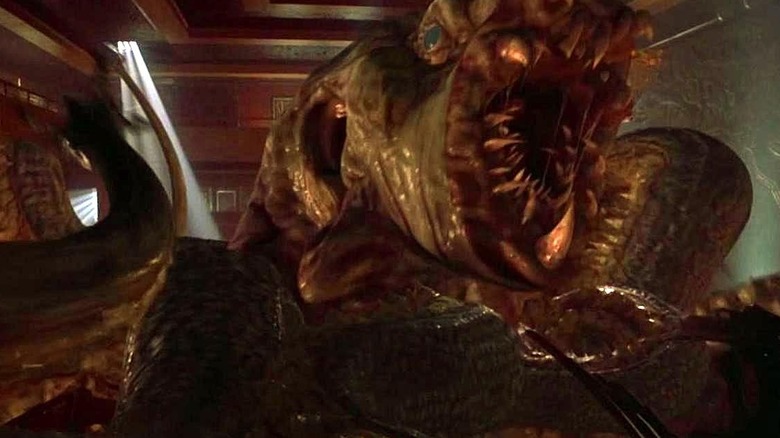Monster Movies You've Probably Forgotten About
You can never have too many monster movies. Westerns, superheroes, rom-coms, sure, but monster movies? Never. However, there are only 24 hours in a day (with at least eight of them spent on work ... lame) so you'd be forgiven for missing some of them. You absolutely must watch the monster movie canon, from black-and-white classics like "King Kong" and "Godzilla" to big-budget Hollywood blockbusters like the "Jurassic Park" series and the Monsterverse. But besides these essential monster movies, there are a lot of high-quality gems. And by "high-quality," we mean raging cinematic dumpster fires — but with monsters!
For our list, we skipped C-list, straight-to-video schlock, SyFy Channel mockbusters, and movies so obscure that not even the directors' moms bothered to watch them. We also excluded human monsters, a la Freddy, Jason, and Michael Myers. Every movie we chose traces its creature feature origins to Willis O'Brien (Kong), Eiji Tsuburaya (Godzilla, Ultraman), and Ray Harryhausen (pretty much everything else). Some of these monsters are based on real animals, just with the volume turned up to 11, while some exist only in their creators' imaginations, which is definitely a good thing. You may remember them, you may have even seen them, but they all share one thing in common: There's a 96.7% chance you barely remember them. Which ones should you watch, and which ones should you skip? Join us as we journey down (monster) memory lane — here are monster movies you've probably forgotten about!
This 1997 horror film is a Relic of a bygone era
Pretty much the only books that make money these days are celeb memoirs, YA novels, and novels you don't want to admit you're actually reading (*cough* "Fifty Shades" *cough*). The '80s and '90s were a much different era. This was the heyday of "airport paperback thrillers" from the likes of John Grisham, Michael Crichton, Tom Clancy, and Douglas Preston and Lincoln Child. The latter duo's unlikely bestseller, "Relic," was about an ancient monster who wiped out the dinosaurs and is now going on a killing spree in the Museum of Natural History during the biggest fundraising gala of the year. How do you not love that setup?
Millions of readers did, making "Relic" a best-seller and getting Hollywood's attention. Released in 1997, the movie inexplicably cut Agent Pendergast, who debuted in the novel and became the centerpiece of several Preston/Child-penned sequels. It also didn't impress critics or moviegoers much, with a 36% critics' score and 34% audience score. But who needs Tomatometer ratings when you have a monster that chomps people's heads off? Well, turns out that wasn't enough, as "The Relic" bombed with $33 million on a $60 million budget. So you probably didn't see it and have completely forgotten about it, but despite all the flak it gets, it's still worth a watch. After all, the creature design is pretty unique, and who doesn't want to see a monster rampaging through a museum? With a cool setting and an interesting beast, we're hoping this delightfully bonkers bomb will no longer be a cinematic relic.
Guillermo del Toro didn't want to Mimic this experience
Film directors tend to follow a tried-and-true path –- get noticed on the indie scene, go to Hollywood, have a horrible experience, redeem themselves (maybe). Enter Guillermo del Toro, who caught Hollywood's attention with his Mexican vampire flick, "Cronos," and made his American debut with 1997's "Mimic." Despite the movie happening more than two decades ago and del Toro since becoming a two-time Oscar winner for "The Shape of Water," the experience of making his first American film still stings. During the BFI London Film Festival (via IndieWire), del Toro didn't mince words, saying, "My first American experience was almost my last because it was with the Weinsteins and Miramax."
So Harvey Weinstein is a bigger monster than the bugs in "Mimic?" No surprise there. Del Toro went on to say, "Two horrible things happened in the late '90s, my father was kidnapped and I worked with the Weinsteins. I know which one was worse ... the kidnapping made more sense, I knew what they wanted." While del Toro hated working on "Mimic," critics dug it, giving the sci-fi/horror flick about mutant insects in Manhattan who can appear like the humans they hunt a respectable 64% on Rotten Tomatoes. Moviegoers were less impressed, judging by the film's 37% audience score and $25 million box office. But we've got to agree with Roger Ebert, who said del Toro "takes the standard ingredients and presents them so effectively that 'Mimic” makes the old seem new, fresh, and scary." In other words, for monster movie fans, del Toro's Hollywood debut can't be mimicked.
Betty White stole the show in this crocodile classic
Given they're essentially prehistoric monsters who went toe-to-toe with dinosaurs, it's surprising (and a shame) that there aren't more movies starring rampaging crocodilians. There's 1980's "Alligator," which finally answered the question, "What happens to baby alligators when you flush them down the toilet?" Answer? They eat lab animals injected with growth hormones and go on a killing spree, duh! Then there's 1999's "Lake Placid," which answers, "What would happen if a 30-foot crocodile lived in a lake in New England and was raised to be a killing machine by Betty White?" This question needed to be answered, and the answer was awesome.
Sadly, critics and moviegoers didn't think so, sinking the croc-run-amok film with 47% and 37% respective Tomatometer scores and a $31 million gross, which didn't earn a profit on its slim $27 million budget. Why, moviegoers? Besides Betty White — whose supporting turn was praised for being "worth the price of admission alone" — you have Bill Pullman, Bridget Fonda, Oliver Platt, and Brendan Gleeson clearly having a blast with TV writer David E. Kelley's smarmy dialogue. It wasn't enough to save the movie, though it did inspire a surprising number of sequels and rip-offs.
This 1977 Jaws knock-off was just plain bizarre
Aquatic predators became big business after Universal's "Jaws" swam into the record books during the summer of 1975. Or so producers thought. Rival studio Paramount wondered, "What's more deadly than a great white shark?" The answer was "Orca: The Killer Whale." Just so there was no doubt, the 1977 thriller even included a scene of an orca killing a great white. Naturally, "Jaws 2" clapped back in 1978 by having the shark leave behind a whale's remains on the beach. It was an unnecessary dig. "Orca" was never any threat to "Jaws" as king of the cinematic seas.
This is despite the fact that "Orca" assembled a very respectable cast — Richard Harris, Charlotte Rampling, Will Samson, and Bo Derek. Clearly, this wasn't meant to be a low-budget mockbuster but a serious tentpole. Alas, "Orca" was horrible, eventually earning a 9% critics' score and 33% audience score, while its $14 million gross would've made "Jaws" laugh (if, y'know, sharks could laugh). This wasn't a thriller, just sillier, with an outrageous story in which the titular whale seeks vengeance on the fisherman who killed his family. That's not a typo — this is a whale revenge pic. Which is kinda awesome and worth a watch, just don't expect the quality of "Jaws" ... more like "Jaws: The Revenge."
Leviathan was part Jaws, part Alien, all turkey
"Jaws" meets "Alien" with a touch of "The Thing" sounds like the greatest Hollywood pitch ever, so we can definitely see why MGM bought into it. Alas, that's all 1989's "Leviathan" is — a shoddy assemblage of much better movies. Here's the story: An evil corporation hires a crew for a mining project in the ocean, but the crew finds a sunken ship and accidentally brings a dangerous monster on board. That's a cool — if cliche — setup, and the film has a pretty stacked cast (Peter Weller, Richard Crenna, Ernie Hudson, Daniel Stern, Héctor Elizondo) and was directed by George P. Cosmatos, the director of "Rambo: First Blood Part II."
Alas, "Leviathan" drowned under the weight of its own mediocrity. The worst part of the movie is what the audience paid to see — the thrills, the kills, and the monster. It just goes to show how much different "Alien" or "Predator" would've been received if their star creatures looked like "Leviathan," which appears to be the love child of Reptilicus and a Kraken on meth. It's bad. Seriously, did they blow the budget on the cast and couldn't afford a legit monster? Anyway, the 24% critics' and 26% audience scores on Rotten Tomatoes tell the tale, as well as the atrocious $15 million box office.
This gory remake is more blah than Blob
With a 68% score on Rotten Tomatoes, the original 1958 "The Blob" starring Steve McQueen is a cheesy, B-movie classic. The remake 30 years later? It's more "blah" than "Blob." During the 1980s, it became trendy to remake sci-fi/horror films from the 1950s with hard-R levels of gore, blood, and violence. The two most famous examples — John Carpenter's 1982 remake of "The Thing" and David Cronenberg's 1986 remake of "The Fly" — succeeded brilliantly. So it's no shock that TriStar Pictures figured they'd strike gold by doing the same thing with "The Blob."
However, both Carpenter and Cronenberg had something to say besides adding more blood; "The Blob" did not. It was just gore for gore's sake. And while the other two commented on the fears and paranoias of the 1980s (much like the original films did in the 1950s), "The Blob" was content to peddle in cheap thrills. Little wonder then that "The Blob" is the least remembered of the bunch. With a 62% critics' score and 56% audience score it's not that bad for the genre, but its $8 million box office and non-existent legacy means plenty of folks didn't see it then and haven't seen it since.
Q is an American kaiju cult classic
Most filmmakers tend to follow familiar origins when it comes to their creatures' backstories — giant animals, aliens, dinosaurs, alien-dinosaurs, the usual. Add a nuclear bomb for a little spice, and you've got yourself a monster. For 1982's provocatively titled "Q — The Winged Serpent," the producers went with a more original backstory — an ancient Aztec god. Before he became infamous as the star of a cult B-movie, Quetzalcóatl was a feathered serpent dating back to the 3rd century CE. About 18 centuries later, Quetzalcóatl went Hollywood, proving even pagan deities can't resist the allure of the silver screen.
Besides having an unorthodox monster, "Q" has a non-traditional story. Michael Moriarty throws caution to the wind playing a New York mobster flunky who finds the mythical monster's nest in the Chrysler Building. Throw in David Carradine and Richard Roundtree as NYPD detectives trying to determine who — or what — is massacring people on rooftops, and you've got the perfect recipe for an entertaining 90 minutes. The film's 71% Tomatometer score shows critics were in on the joke, while its 42% audience score and atrocious $255,000 box office shows moviegoers weren't. Not a lot of people saw "Q," but we know for certain who did — Dean Devlin and Roland Emmerich, as the ending to 1998's "Godzilla" is virtually a shot-for-shot remake of the big finale in "Q."
Carnosaur is a bloody rip-off of Jurassic Park
Any movie can rip off a blockbuster after it comes out. But before? That takes a special kind of knock-off. Enter "Carnosaur," which was rushed into production and theaters on May 21, 1993 in order to beat the blockbuster creature feature it was cribbing, "Jurassic Park," released on June 11, 1993. While you've got to admire that work ethic, it didn't really help, as "Carnosaur" only mustered a measly $1.7 million, less than "Jurassic Park" made in one hour.
The movie is about a mad scientist who plans to wipe out humans with flesh-eating dinosaurs in order to protect the planet, but only a security guard can stop her. Like John Hammond, "Jurassic Park" spared no expense when it came to making realistic dinosaurs. "Carnosaur" went, uh, another route and focused less on realism, more on gore. Of course, the movie was bloody mess, resulting in a 10% critics' score and 23% audience score on Rotten Tomatoes. Interestingly enough, "Carnosaur" stars Diane Ladd as the mad scientist. For those who don't know, she was a film and TV star of the 1970s and 1980s, and she's also Laura Dern's mother, who played Dr. Ellie Sattler in "Jurassic Park." We're sure they talk about dinosaur movies all the time.
The Water Horse was a whimsical family fable
Not every monster movie has to be a horror or sci-fi film. "The Water Horse: Legend of the Deep" is the only movie on this list that isn't scary ... well, it's the only one that isn't meant to be scary. "The Water Horse" is a family friendly fable about the world's most famous cryptid (all due respect to Bigfoot) — Nessie, the Loch Ness Monster. A boy in the Scottish highlands finds an egg, which hatches to release a mythical water horse. What follows is a familiar storyline as the lonely boy and the creature become best friends, and the kid has to hide the water horse from his mom and bad guys who want to capture him.
Have we seen this setup 10 million times before? Yes. Do we care? Not when it's done as well as "The Water Horse." The movie earned a respectable 74% critics' score and 62% audience score on Rotten Tomatoes, and it made a profit with $103 million worldwide on a $40 million budget in 2007. So why did you (probably) forget it? Blame the timing, as the 2000s were packed with family films competing for the money in mom and dad's wallet. If you didn't catch it the first time, "The Water Horse" is definitely worth a watch.
Virus is so bad it'll make you sick
"Virus" is the type of movie where you may remember the poster or trailer and go, "Oh yeah, that movie." We'd be impressed, and a little suspicious, if you've actually watched it. Put simply, "Virus" is bad. How bad? A 12% critics' score and 21% audience score on Rotten Tomatoes bad. In the film, a tugboat crew caught in a typhoon boards a mysterious vessel ... despite warnings of the sole survivor to not go near it. Wouldn't you know it, there's an evil alien on the ship that views the humans as a virus and begins killing them off in horrific ways one by one.
"Virus" really wants to be "Alien" at sea, but despite a fairly strong cast — including scream queen Jamie Lee Curtis, Donald Sutherland, and William "Did You Mean to Cast Alec?" Baldwin — "Virus" just can't get past the hump of its own pointlessness. It's basically "Sphere," "Red Planet," or a million other late '90s, early 2000s movies where the filmmakers skipped an original story and thought they could just throw special effects at the screen and make money. It didn't. Given the cinematic death sentence of a January release date, "Virus" made a minuscule $30 million on a $75 million budget in 1999. That's a big enough bomb to make any movie studio sick.
Mighty Joe Young is Disney's take on the great ape
Think the "giant gorilla movie" subgenre only includes "King Kong" movies? Not even close. While there's no shortage of bawdy, bewildering, and just plain bad Kong knock-offs, the most famous rip-off — 1949's "Mighty Joe Young" — is actually really good, with a 95% Tomatometer score. So, given "Mighty Joe Young" is much more kid-friendly than "Kong," it was exciting when Walt Disney Studio decided to remake this story of a young woman and her pet giant gorilla monster for the 1990s. However, the Mouse House didn't have much luck with the big ape.
Despite starring a post-"Twister" and "Apollo 13" Bill Paxton (and, y'know, a giant freakin' gorilla), "Mighty Joe Young" bombed in '98, earning a less-than-mighty $50 million on a $100 million budget. And despite also starring a pre-"Monster" and "Mad Max: Fury Road" Charlize Theron, it wasn't that good either, earning a mediocre 55% critics' score and 40% audience score. While "Mighty Joe Young" wasn't very memorable, it was historic, as it encouraged Universal to postpone their "King Kong" remake for seven years, during which time the would-be remake's director — Peter Jackson — made the little-seen indie hit "The Lord of the Rings." So thanks, Joe!
Deep Rising could have deep-sixed its director's career
"Deep Rising" is not to be confused with another movie released in 1998, "Deep Impact," which isn't to be confused with the other asteroid movie released that year, "Armageddon." Confused yet? Well, "Deep Rising" isn't an asteroid movie but a pirate movie, albeit set in the present day. A pirate monster movie sounds like the greatest thing ever, right? Not so fast.
In the film, a newly unveiled ocean liner on its maiden voyage is invaded by jewel thieves, who also have to contend with a larger threat — a murderous kraken. Despite that insanely awesome setup (and the equally amazing tagline of "Full Scream Ahead"), "Deep Rising" doesn't really deliver, as it only managed a 28% critics' score and 43% audience score on Rotten Tomatoes after it was released in January 1998. Its January release date proves the studio's lack of faith, and they were right to be skeptical, as "Deep Rising" drowned with $11 million.
If you've forgotten "Deep Rising," the director Stephen Sommers is probably glad you did. He immediately followed this 1998 flop with the 1999 blockbuster "The Mummy," which earned $416 million worldwide, more than 40 times what "Deep Rising" made. That might be the biggest and quickest comeback in monster movie history.
